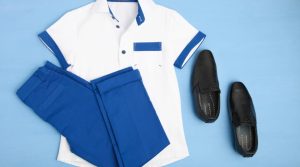Table of Contents
When building a business wardrobe, whether for staff uniforms, trade show kits, or internal team gear, colour is often one of the first things to consider.
It seems like a simple choice on the surface, but colour has a measurable impact on how your business is perceived, how confident your team feels, and even how practical clothing is to maintain.
While logos and branding often guide these decisions, the colours you choose for your business apparel should do more than match your hex code. They should function well across real working environments and meet the needs of your team in practice, not just in theory.
So, how do you strike the right balance between brand identity and day-to-day wearability? Here’s what to keep in mind.
What Makes Colour Choices in Professional Apparel So Crucial for Workplace Success?
Understanding Colour as a Workplace Tool

Colour psychology isn’t just for marketing. It affects how your staff feel wearing the uniform and how customers interact with them.
Blue, for example, often conveys reliability and calm, making it ideal for professional services. Green might suggest eco-awareness or balance, while red leans toward energy and urgency.
But while these associations are useful, they shouldn’t override practicality. Wearing bright red every day might suit a bold brand, but it may not be ideal in a physically active job or one where stain visibility is a concern.
In many cases, choosing colours that subtly reference your brand, like a navy variant of your royal blue logo, offers a functional middle ground.
Learning from Industry Trends
Brands like AWDis, which design garments for customisation, offer a helpful case study in managing colour at scale. Their collections, such as Just Hoods, which spans over 90 colour options, demonstrate that you don’t have to be limited to a binary choice of black or white when planning business clothing.
In fact, their approach is built for flexibility: multiple tones of similar shades (light grey, charcoal, heather), muted colours suitable for work environments, and vibrant options for teams that want more visibility.
What’s useful about this approach is that it mirrors how businesses are moving away from rigid, one-size-fits-all uniforms and leaning toward mix-and-match options that still look cohesive.
A receptionist in a polo shirt and an engineer in a hoodie don’t have to match exactly, but shared colour cues can tie the look together without feeling overly uniform.
The Practical Side of Colour
Let’s talk maintenance. Some colours will naturally wear better than others over time, especially if staff are frequently outdoors, on the move, or working in environments where dirt or stains are common.
Here are a few general rules of thumb:
- Darker shades (navy, charcoal, forest green) tend to age well, resist staining, and still look professional.
- Lighter tones (white, pastel blue) can look crisp and clean but may require more frequent washing or replacement.
- Bright colours are great for visibility (ideal for event staff or large-scale public-facing roles) but may fade faster with regular washing.
The takeaway? Consider what your team actually does in their clothing. The best brand colours in the world won’t help much if they fade or stain within a few weeks of wear.
Inclusive Colour Options

It’s also worth thinking about how colours will look on different body types, skin tones, and roles within the business. Offering two or three core colour options, rather than one fixed choice, can help accommodate a more diverse team while still maintaining a professional, unified look.
Some companies are now taking this further by choosing “neutrals with personality”: colours like olive, burgundy, or slate grey that feel a bit more modern but still fit within a business context.
Choosing Colours That Scale
If your team is growing, or likely to, make sure the colours you choose are easy to reorder and replicate over time. Limited-run fashion colours might look good initially, but they could be hard to match when you need more stock.
Standardised colours offer a more sustainable option for businesses planning for scale. Having the same navy or graphite shade available across T-shirts, hoodies, and polos makes it easier to manage stock, replacements, and supplier consistency.
Final Thoughts
Colour isn’t just aesthetic, it’s functional. When used well in business apparel, it supports team identity, boosts confidence, and reinforces brand recognition without becoming a burden.
It’s tempting to go all-in on a bold visual identity, but real-world use matters just as much. Choosing a colour strategy that balances visibility, durability, and practicality will pay off over time, in saved replacements, happier staff, and a more consistent brand presence.
As the shift towards sustainable and customisable workwear continues, companies that take a more thoughtful, inclusive, and adaptable approach to colour are better positioned to stand out and hold up.


